Around this time last year, I wrote a lengthy post about my writing activities in order to kick myself into higher gear. It worked. I didn’t meet every goal I set, but that doesn’t really bother me, for reasons detailed below. Writing a “year end” sort of post now, rather than at the end of the year, was a boost to my production last year, and we’ll see if it happens this go-round.
What’s new, pussycat?
This year’s writing theme, if you can say a year has a theme, has been “blending.” For many years I pursued creative writing largely apart from what I do as a librarian. One of my colleagues at VCU, Jenny Stout (review blog), started a discussion series within our division this year, “Research and Learning: Living Up to Our Name,” where people talk about aspects of their work, conceptual developments in the field, etc. She got the series off to a start with an hour of micro-talks, and I spoke about hunting for overlap in activities from different parts of your life, in order to increase efficiency, work strategically, etc. This has been productive for me, as I’ve found myself more dedicated to and interested in both scholarship and creative writing. I have no intention of blogging about my career as a librarian (God forbid; the internet is already littered with unread biblio-blogs), but selected contents & activities are another story.
Intersections
This week I submitted an article to a high-profile professional publication about work I did with a creative writing class at VCU. A submission is not an acceptance, but I’m a heck of a lot happier with that than with the idea lying in unquiet repose in my brain.
Next semester I am co-teaching with Tom De Haven a semester-long class about writing research-intensive fiction. This is aimed at students interested in developing both research skills and a proficiency at incorporating research into their fiction. Course description (ENGL 437).
Next March I’ll be delivering a paper at the International Conference for the Fantastic in the Arts (ICFA 36). This paper will blend a lifelong literary interest and my more recent interest in digital humanities methodologies. Its title is “Node, Edge, or Tentacle? Data and the Lovecraftian Literary Network,” and it’s about a computational analysis of Selected Letters.
I have various future scholarly activities in the works associated with the above agenda(e). Just what form they take depends to some extent on how things go this spring, and realistically they aren’t going to be started until summer, but it’s good to have plans.
Into the field
This year I’ve read many good books, and some excellent ones. I’ve heard a number of people talking about a new golden age for the Weird, even a Weird Renaissance, and it’s hard to argue. From a score of anthologies, including the VanderMeers’ monumental The Weird, to continued excellence from Weird Fiction Review, to Mike Kelly’s establishment of Year’s Best Weird Fiction, things are coming up Weird all over. The kind of horror I like to read, which has a strong overlap with Weird, but not entirely, seems to have surged as well.
One of the best things I’ve read this year (am still reading, actually) is John B. Thompson’s Merchants of Culture: the Publishing Business in the Twenty-First Century. Ross Lockhart, who has himself been having an impressive year, was talking about the book a couple months back, and so I picked it up. So glad I did. Merchants of Culture is an analysis of contemporary publishing in terms of Bourdieuian fields, among other things. I’ve spent a lot of time over the last decade trying to wrap my head around publishing and writing, and this book was part of what reshaped my thinking about authorship this year, from the role of scholarship in my creative life to the places where I aspire to publish.
I regularly attend the Annual Conference of the American Library Association, but this academic year I’m attending or have attended various other meetings. I was invited to attend/speak at Digital Humanities and the Dartmouth College Library, a one-day event in advance of The Digital Crucible, a conference focused on computation in the arts and humanities. Last month I attended the James River Writers Conference here in Richmond, where I moderated a panel entitled “Write What You Research.” Last weekend I attended the 40th World Fantasy Convention, where I met people across the range of activities in the fantastic arts (more on that another day). Next year I’m pleased to be guesting at RavenCon here in Richmond. The list of people I’ve met as a result of all of these activities is in the hundreds, so I’m not doing a roll call, but I will say that in the process I’ve made new friends, met heroes, and gotten a better understanding of the ecosystem of the writing world. I did (or am doing) all of this for a host of reasons, but Merchants of Culture led me to view my activities through a new and improved lens.
What have I accomplished in 2014?
Let’s go to the data…
I could talk about this in various ways, but I think the easiest thing to say is that I feel like I’m back on track. If I’d tracked things by month, and only shown the last two or three years, the difference would be even more stark.
Old goals
Write at least 100,000 words of completed or truly “in progress” fiction rough drafts by December 31, 2014.
Didn’t happen. The last day I added to my count, it was around 18,000. Since then I’ve written three stories, substantially revised several stories, and started and abandoned a novel.
Place six pieces of fiction for publication.
Placed three, which was actually my “good enough” goal, so I’m fine with that. I’ve got four stories out right now, one of which is a “hold for consideration,” so that’s good.
Get back to blogging.
Check.
Read at least two books per month.
Some months it was only one, but some months it was four, so… check.
2015 goals, you say?
Some of this is going to sound familiar, but…
- Write at least 100,000 words of completed or truly “in progress” fiction
- Complete enough thematically similar short fiction for a strong collection
- Place six pieces of fiction and one essay for publication
- Find a home for my Seattle magical realism novel
- Draft two new scholarly articles or opinion pieces
- Keep blogging
- Read at least two books per month
I have a few other things on the stove, as well, some on front burners and some on the back, some small and some large. Further bulletins as events warrant.
And last but not least, thanks are more than due to my friend, partner, wife, and sine qua non, Kyla Tew. Without her support and patience, it would be difficult to do this.













